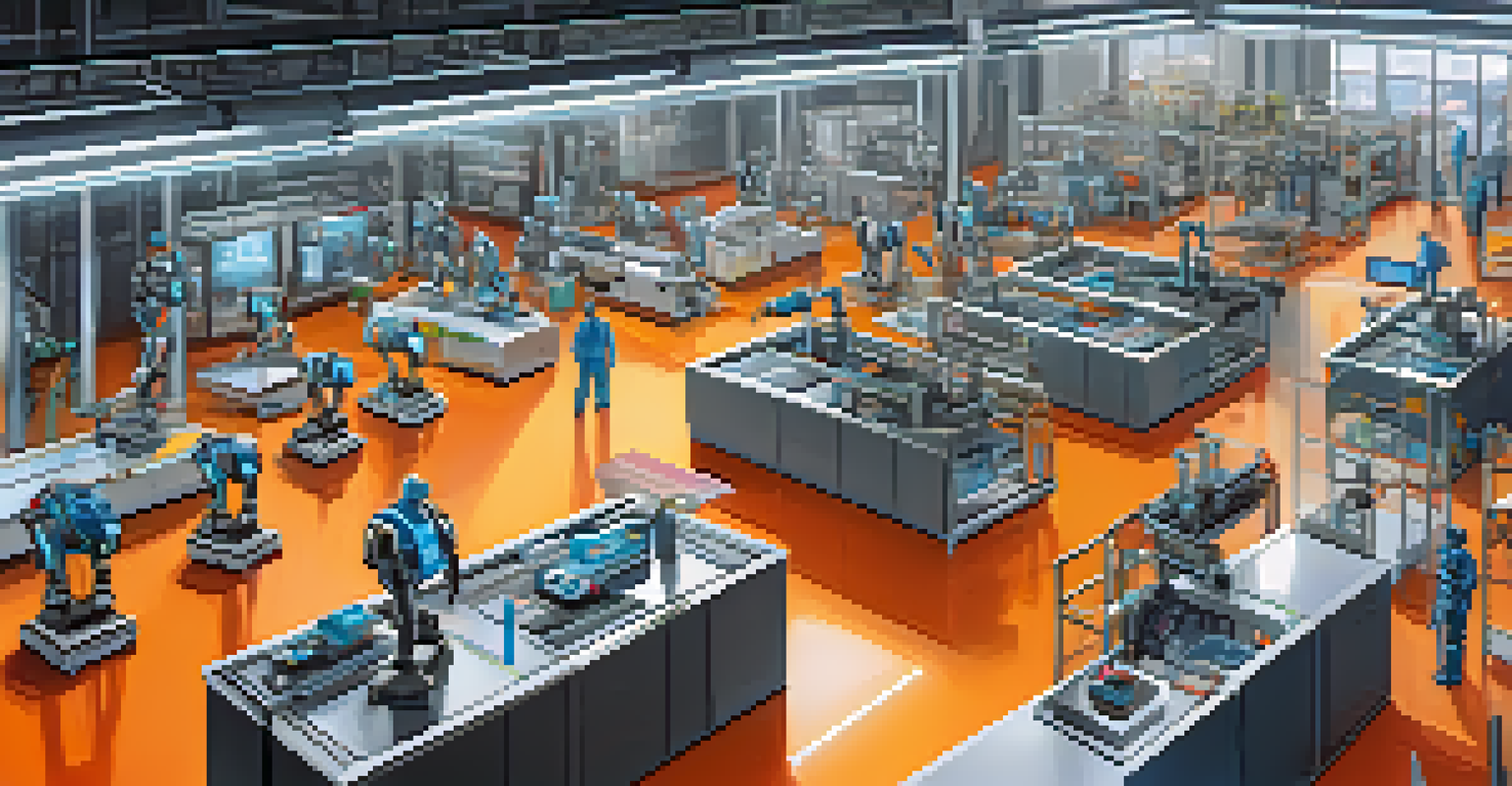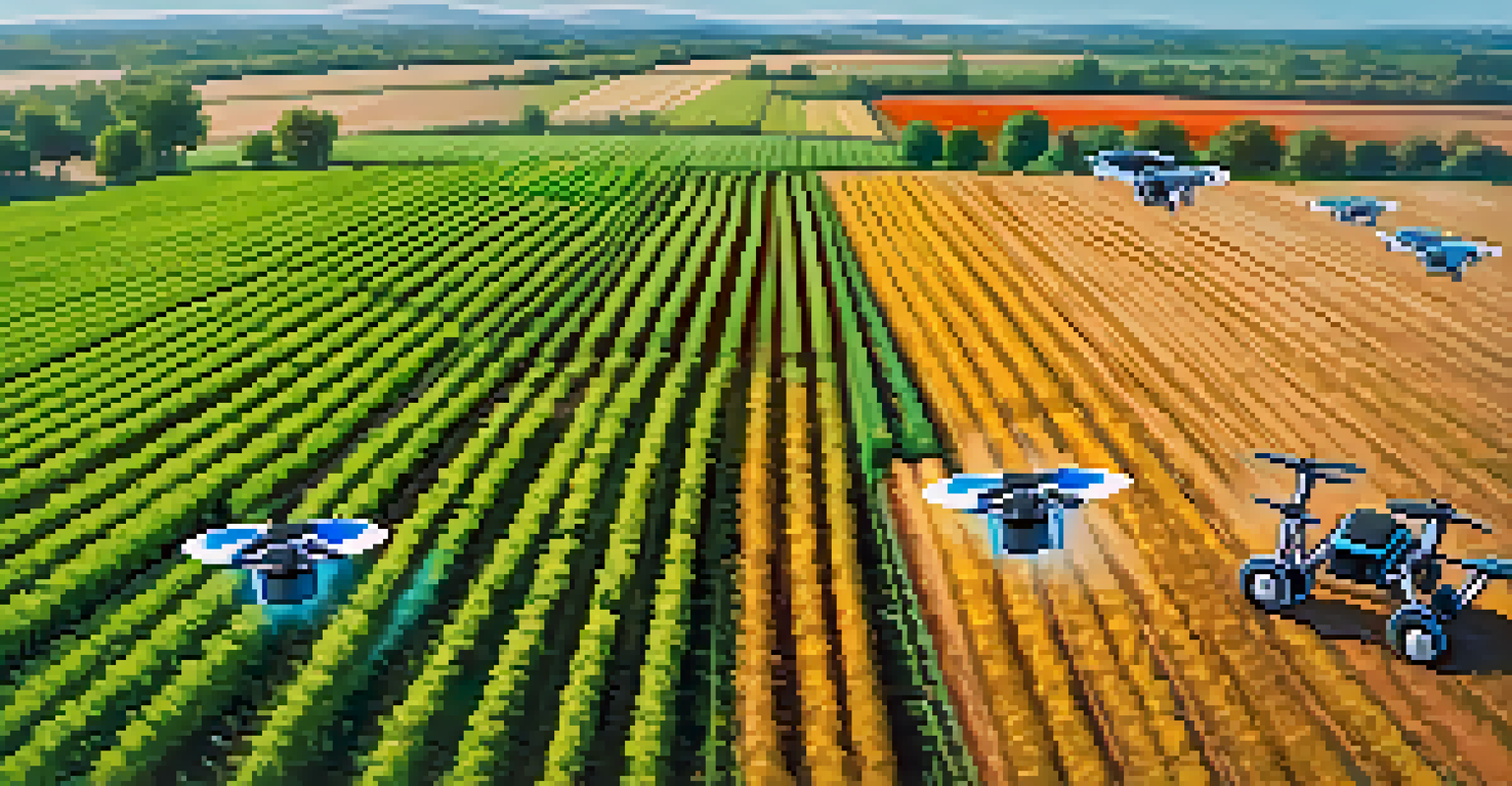AI and Robotics: Collaborating for a Smarter Future

Understanding AI and Robotics: A Dynamic Duo
Artificial Intelligence (AI) and robotics are two powerful forces shaping our world. While AI focuses on enabling machines to learn and make decisions, robotics involves the physical creations that perform tasks. Together, they create a synergy that enhances capabilities, making tasks easier and more efficient. Think of it like a dance; AI provides the rhythm, while robotics bring the choreography to life.
The future is already here – it's just not evenly distributed.
This collaboration is evident in various sectors, from manufacturing to healthcare. In factories, AI algorithms optimize production lines, while robots execute the physical assembly. In hospitals, AI analyzes patient data, and robotic systems assist in surgeries, showcasing how these technologies complement each other. The result is a more streamlined process, leading to better outcomes.
As we delve deeper into this partnership, it’s essential to recognize the potential benefits it brings. Increased efficiency, reduced costs, and improved safety are just the tip of the iceberg. By combining the analytical prowess of AI with the precision of robotics, we are paving the way for a smarter, more capable future.
How AI Enhances Robotic Capabilities
AI technologies significantly enhance the functionality of robots, making them more autonomous and adaptable. For instance, AI-powered robots can learn from their environment and adjust their actions accordingly. This adaptability is crucial in unpredictable settings, like disaster response, where conditions can change rapidly. Imagine a robot trained to navigate through rubble—AI allows it to analyze its surroundings and find the best path forward.

Moreover, AI enables robots to process vast amounts of data in real-time. This capability is crucial in industries such as agriculture, where drones equipped with AI can monitor crop health and make decisions about irrigation. By analyzing data from various sources, these robots help farmers optimize their yields and reduce waste. It’s a perfect example of intelligence meeting action.
AI and Robotics: A Powerful Team
The collaboration of AI and robotics enhances efficiency across various sectors, streamlining processes and improving outcomes.
In essence, AI not only empowers robots to perform tasks but also equips them with the intelligence to make decisions. This combination leads to greater autonomy, allowing robots to tackle complex challenges without constant human oversight. As AI continues to evolve, we can expect even more sophisticated robotic applications.
Robotics in Everyday Life: AI's Role
AI and robotics are becoming increasingly integrated into our daily lives, often in ways we might not even recognize. From smart home devices that learn our preferences to robotic vacuum cleaners that autonomously navigate our homes, these technologies enhance our convenience. Picture waking up to a coffee brewed by a robot that knows just how you like it—this is the future we are stepping into.
Technology is best when it brings people together.
Even in customer service, AI-driven robots are starting to play significant roles. For example, chatbots can handle inquiries, while robotic kiosks can assist with transactions. This not only improves efficiency but also allows human employees to focus on more complex tasks, enhancing overall service quality. It’s a win-win for businesses and consumers alike.
As these technologies become more commonplace, the line between human and machine interaction continues to blur. The more comfortable we become with AI and robotics, the more seamlessly they will integrate into our lives. This integration looks to redefine how we interact with technology and with each other.
The Impact of AI and Robotics on Employment
One of the most discussed topics surrounding AI and robotics is their impact on employment. While there are concerns about job displacement, it's important to recognize that these technologies also create new opportunities. For example, as robots take over repetitive tasks, humans can shift towards more creative and strategic roles. Think of it as a transformation rather than a loss; the job landscape is evolving.
Moreover, new jobs are emerging that focus on developing, maintaining, and programming these advanced technologies. Roles in AI ethics, robotics engineering, and data analysis are becoming increasingly essential. As businesses adopt these technologies, they will require a skilled workforce to harness their full potential, leading to job creation in fields we may not have imagined a decade ago.
Job Evolution Amid Technology
While AI and robotics may displace some jobs, they also create new opportunities that require human creativity and strategic thinking.
Ultimately, the relationship between AI, robotics, and employment is complex. While some roles may diminish, others will flourish, highlighting the importance of adaptability and continuous learning. Embracing this change allows us to prepare for the future and leverage the benefits that AI and robotics offer.
Challenges in AI and Robotics Collaboration
Despite the promising future of AI and robotics, several challenges must be addressed for successful collaboration. One significant hurdle is ensuring that these technologies work harmoniously together. Miscommunication between AI systems and robots can lead to inefficiencies or errors in critical situations, such as in healthcare or manufacturing. It’s crucial to establish seamless communication protocols for optimal performance.
Another challenge lies in ethical considerations. As robots equipped with AI become more capable, questions about decision-making and accountability arise. For instance, in autonomous vehicles, determining who is responsible in the event of an accident is a complex issue. Addressing these ethical dilemmas is vital to gain public trust and acceptance of AI and robotics.
Lastly, the rapid pace of technological advancement can lead to a skills gap. As industries adopt these technologies, there is a growing need for training and education. Ensuring that the workforce is prepared to work alongside AI and robotics is essential to maximize their potential. Tackling these challenges head-on will pave the way for a more effective collaboration.
The Future of AI and Robotics Collaboration
Looking ahead, the collaboration between AI and robotics holds immense promise for numerous industries. As these technologies continue to evolve, we can expect even more innovative applications that enhance our daily lives. From smart cities equipped with autonomous public transport to AI-assisted medical diagnostics, the possibilities are limitless. This partnership is not just about automation; it’s about creating solutions that improve quality of life.
Moreover, as we develop more advanced AI algorithms, robots will become increasingly capable of complex tasks. This will enable them to participate in areas like elder care, where they can assist with daily activities, offering companionship and support. Imagine a future where robots not only help with chores but also enrich our lives through social interaction.
Navigating Ethical Challenges
Addressing ethical considerations and ensuring effective collaboration between AI and robotics are crucial for their successful integration into society.
Ultimately, the future of AI and robotics is a collaborative one, where both technologies enhance each other's strengths. As we embrace this future, it’s vital to prioritize ethical considerations and workforce readiness. By doing so, we can ensure that this collaboration leads to a smarter, more equitable world for everyone.
Conclusion: Embracing a Collaborative Future
In conclusion, the collaboration between AI and robotics is shaping a smarter future that promises to transform our lives. As these technologies work hand in hand, we can expect increased efficiency, new job opportunities, and innovative solutions to complex challenges. It’s an exciting time to witness the evolution of these technologies, and being open to their potential is crucial.
However, we must also remain vigilant about the challenges that come with this progress. Addressing ethical concerns, ensuring seamless integration, and preparing the workforce are essential steps to fully harness the benefits of AI and robotics. By facing these challenges together, we can create a future that is not only smarter but also more inclusive.

Ultimately, embracing the collaboration between AI and robotics opens doors to endless possibilities. Whether it's in our homes, workplaces, or communities, this partnership will redefine how we interact with technology and each other. As we look forward to this exciting future, let’s commit to shaping it thoughtfully and responsibly.